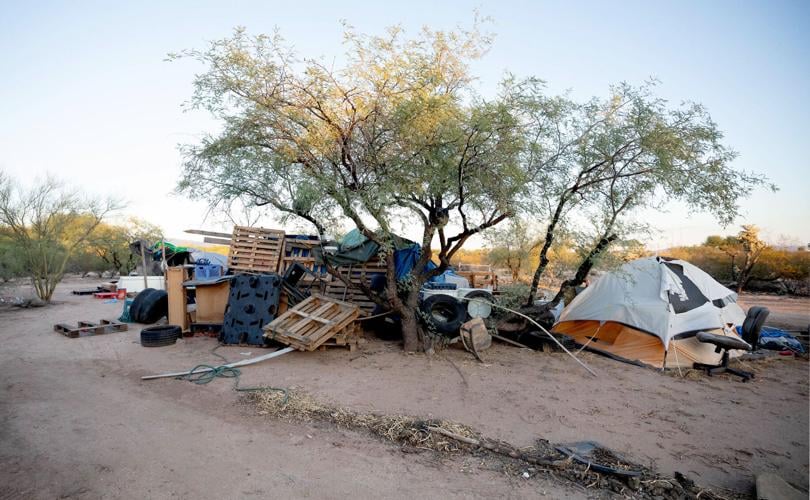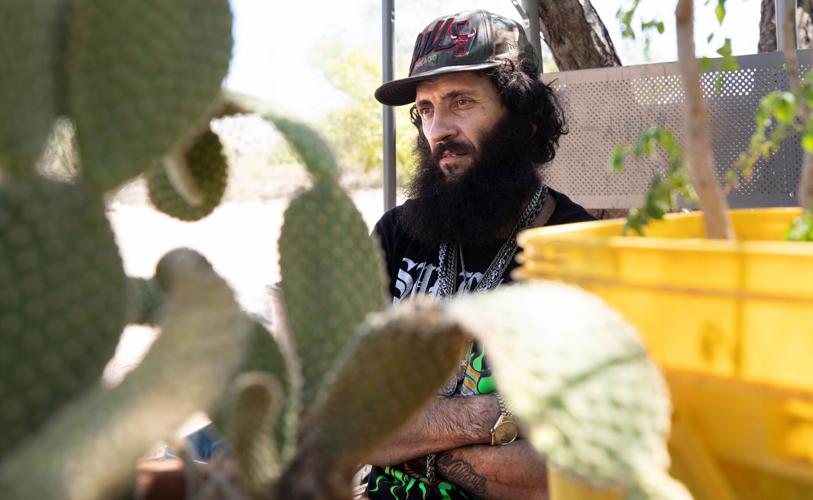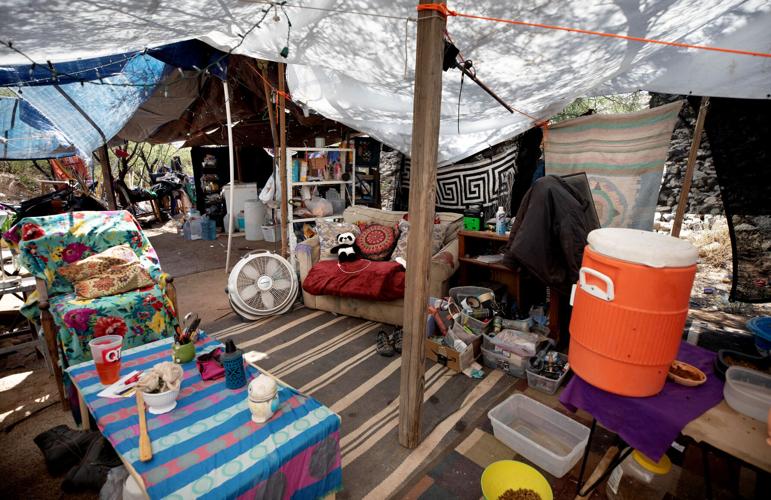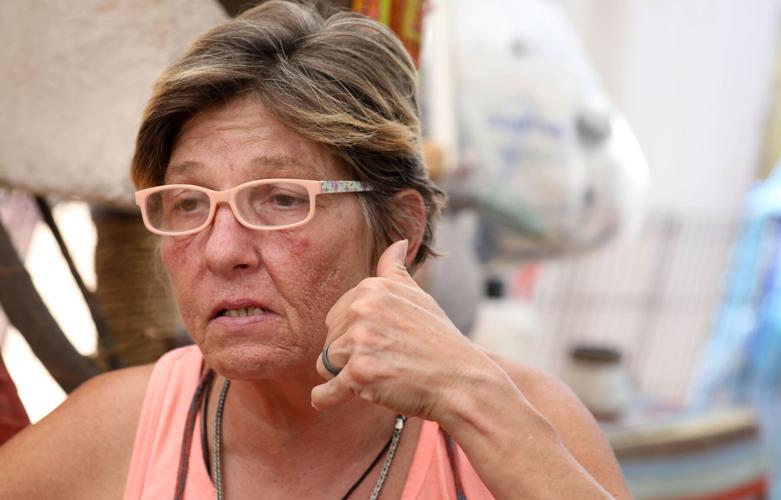Driving along East Golf Links Road, you get a vague sense there are a lot of tents down there, beyond a stretch of desert, nestled in a patch of trees.
There are — many more tents than you can see. Dozens and dozens.
The 100-Acre Wood sits where Golf Links Road curves south, on a patch of ground owned by Davis-Monthan Air Force Base but leased by the city. It got its name when it became a mountain-bike park in 2019, but there’s not so much mountain-biking there now.
Instead there are people, lots of them, living scattered among the washes and trees. As many as 200-300 have been living there, said Nora Powers, who visits the site often as part of her work for HOPE Inc.
It is not formally a city-sanctioned camp — those don’t exist in Tucson. But informally it has operated with the perceived sanction of local officials and agencies, residents told me. Some said police officers or other officials suggested they move there.
Matt Mullins had been living outside near East Pima Street and North Swan Road last summer when he was rousted by police, he told me.

Matt Mullins had been living outside near East Pima Street and North Swan Road last summer when he was rousted by police, he told me. “The cops were telling us ‘Get out of here, get out of the streets. Too many calls on you guys.’ And we were like ‘Where do we go?’ They’re like, ‘Go to the 100 Acres and we won’t bother you there.’ ” He’s been in the area, known to many residents as “The Acres,” for a year now, creating an impressive spread among the trees.
“The cops were telling us ‘Get out of here, get out of the streets. Too many calls on you guys.’ And we were like ‘Where do we go?’ They’re like, ‘Go to the 100 Acres and we won’t bother you there.’ ”
He’s been in the area, known to many residents as “The Acres,” for a year now, creating an impressive spread among the trees.
What the unhoused residents have in The Acres is no paradise. There is no water service, no toilets. But it has been a somewhat functional home for a lot of people used to dysfunctional lives.
It’s even separated from the nearest neighborhood by a high levee. The one activity the camp really interrupts is the effort by the Sonoran Desert Mountain Bicyclists to provide an accessible space for city youth to cycle in. And that is a real shame.
‘I don’t even feel homeless’
The rumble of generators reverberates from several camps, one of them Mullins’ place. He told me he powers a refrigerator, a freezer, a window AC unit, a TV and lights.
“It’s pretty nice,” Mullins said. “It’s kind of like I don’t even feel homeless.”
Indeed, he has a fence around much of his camp, made of materials donated by a metal scrapper who comes around, he said. And other residents stop by with their pups for doggy play dates. Even housed friends come and stay sometimes.
About 150 yards to the west, Cece Kon lives in a separate cluster of tents. She doesn’t consider herself exactly homeless, because she owns an RV parked down there. But it isn’t quite operational now.
“I feel more homeless now when it’s broke down and I don’t have options,” she said, sipping on her favored brew of cream soda and Fireball whiskey.
She and others with vehicles are worried because the city recently tagged them for removal. She’s overdue to move, Kon said. But in the six months she’s been here, she feels like she’s established a bit of a sanctuary under the tarps.
As with most homeless camps, the area is rife with people on “blues,” the opioid pills often containing fentanyl that are a scourge around the city and country. She tries to build neighbors’ confidence, giving them “more incentive and motivation for their lives than just getting high.”

The living room inside of Cece Kon’s shelter at the 100-acre wood near East Golf Links Road on Wednesday.
“When they’re here, I think I’m getting through to them, but really they’re trying to see themselves the way I see them,” she said. “I don’t think that they’re really convinced, once they leave here, that that’s really who they can be.”
Sanctioned camps opposed
City Council member Steve Kozachik, who represents the area, told me he thinks the 100-Acre Wood could make a great site for a sanctioned homeless camp with more controls and fewer people.
“Right now it’s out of control,” he said. “Where sanctioned camps have worked, it’s maybe 20 people in a controlled area with services that come by daily. Law enforcement comes by daily.”
Mayor Regina Romero opposes the idea of the city sanctioning camps, as some other cities have, and the council seems in no mood to set up such places. In fact, residents foresee The Acres being cleared out again soon, as it has before.
Previously, the city had placed roll-off trash bins down there but more recently they were removed. There has also been a recent round-up of shopping carts, which Kon said hurt everyone’s ability to go get water. Finally there was the tagging of all the vehicles. Some people have been moving out.
Mari Vasquez, who coordinates the city-county responses to homelessness, said each camp within the broader 100-Acre Wood is considered a separate site under the city’s homeless protocol. That means they can each be judged individually as to whether they must be removed or can simply be monitored.
About two weeks ago, the city led a big outreach effort that included vaccines for animals as well as healthcare assistance for people and a broad offering of social services.
“It’s one of the larger encampments that needs an all-hands-on-deck approach,” Vasquez said.
Indeed, social-service employees like Powers are frequent visitors. The Acres may not be formally sanctioned, but the area is watched.
No complaints
One of the key reasons the city breaks up a camp is if the residents are causing problems, such as crime, in nearby neighborhoods. Kozachik told me his office hasn’t heard complaints.
I spoke with four residents of East 32nd Street, which is just over the levee from the camps, and they all said issues have been minimal. One, Judy Hubbard, worries about fires; another, Ronnie Tarkington, told me “you can see them all night going in the trash with their flashlights.”
Those who are really put out by the camps are bikers who may logically avoid the 100-Acre Wood’s trails and jumping ramps. I’ve ridden there maybe five times, but not in the past couple of years as the unhoused population has grown.
In 2021, someone broke into a shipping container at the site, put there by Sonoran Desert Mountain Bicycles, and stole many thousands of dollars of equipment. Kirk Astroth, president of the group, told me once he was down there and was chased by a dog belonging to one of the homeless residents.
“A few mountain bikers have contacted us and told us they don’t think it’s safe down there,” he said. “Nobody was being physically harmed. I think it was more of a fear factor than it was real danger.”
This fall, a large state grant and a private grant may come through to pay for building more trails, Astroth said. If that happens, it may mean that the whole area is cleared again when construction begins. By then the city may have more housing to offer.
Bigger than the safety issue is the lost opportunity. As club secretary Leif Abrell, a friend of mine, noted, part of the idea of the trails is to make mountain biking accessible to more young people.
“It’s a location that’s accessible to south Tucson youth,” Abrell said. “A main goal of our club is to make mountain biking look a little less like middle-aged white guys all the time. Most Tucson kids, their parents can’t drive them to the trailhead or buy a $3,000 or $5,000 bike.”
So while I’ve admired the relative functionality of the 100-Acre Wood camp, I have to acknowledge something is lost by allowing it to linger. Just as something is lost — housing and a community — by taking it down.







